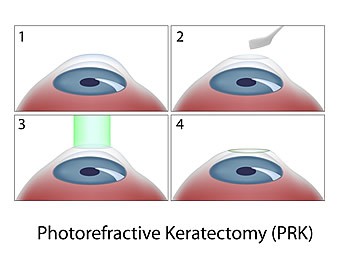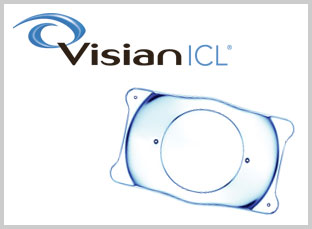LASIK Alternatives
PRK (Photo-Refractive Keratotomy)

The procedure can be performed once the eye has been numbed with anesthetic drops. A speculum will be positioned to hold your eyelids back just like in LASIK so that your eyelids will not interrupt the actual surgery. The eye surgeon will then remove the outer cornea cells and proceed with the actual laser treatment. The laser is then positioned to directly treat the cornea. This laser delivery takes less than one minute to complete for most patients. Once the laser treatment or refractive ablation is completed, the corneal curvature is reshaped, thus improving the refractive error. Your ophthalmologist will then place a bandage contact lens on the eye for improved comfort along with anti-inflammatory and antibiotic eye drops.
Post-operatively, our patients will be re-evaluated one day, three days, one week, one month, two to three months, and four to six months following the PRK procedure. The bandage contact lens can usually be removed on the second or third post-operative day when the epithelium is healed. Many patients will only require eye drops to control healing during the first 6 to 12 weeks, but other patients may require topically applied medications for up to 6 months or more following the procedure. The greater the refractive error, the more likely the patient is to require eye drop medications for a prolonged period following the procedure.
PRK differs from LASIK in that no flap of tissue is created prior to resculpting the cornea with the excimer laser. In LASIK, this flap creation does enable a faster recovery period.
What is a “Phakic IOL or ICL”?
A Phakic IOL is an artificial lens that is placed permanently inside a patient’s eye to correct high amounts of nearsightedness without removing the patient’s own natural lens. It is also known as the “implantable contact lens” (ICL). The phakic IOL acts in concert with the patient’s own lens and cornea to allow light rays to focus on or near the retina, thereby diminishing or (possibly) eliminating the patient’s very high degree of nearsightedness.
This lens is made of either medical-grade plastic (polymethylmethacrylate), or a new high technology co-polymer consisting of a combination of soft contact lens material and collagen and has been used since the late 1970s to optically correct the eye once the natural lens of the eye has been removed during cataract surgery. Morristown Ophthalmology Associates, P.A. offers the Visian ICL which has been approved by the FDA to be implanted into the eye without removal of the patient’s own natural lens.
For someone who is nearsighted, the eye bends or refracts too much incoming light and this causes the eye to focus before it reaches the retina, the back of the eye. To correct vision, the eye’s refractive power needs to be reduced and whether it is done with glasses, contacts, LASIK, PRK, or a Visian ICL, the correction involves bending light, delaying its focus until it reaches the retina.
What are the Advantages of the Visian ICL?






